
Oct 12 2022
10 min read

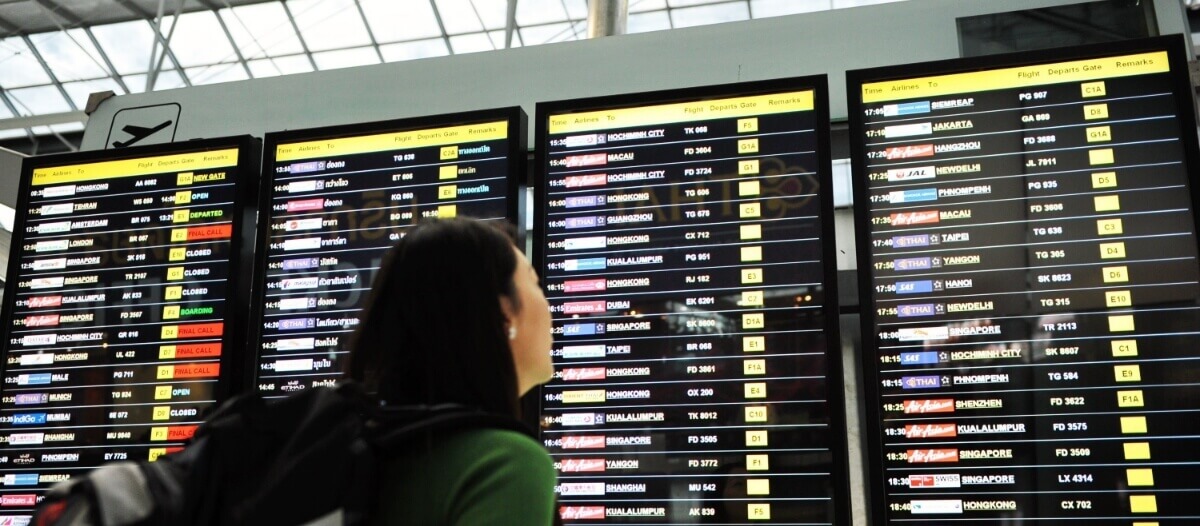
Apr
Since the inception of digital signage, airports have been ready adopters of this technology. The reason was quite apparent. Considering the busy schedule and the crowd pouring in every minute, airport digital signage solutions came to the rescue.
With visible positive results in both work management and the traveler’s experience, airports incorporate digital signage more to make transit smart, enjoyable, and efficient.
The International Air Transport Association (IATA) expects overall traveler numbers to reach 4.0 billion in 2024, exceeding pre-COVID-19 levels by 103%. With these many people rushing to fly, airports will need more digital displays and a powerful implementation strategy.
In this blog, we will see why a growing number of airports are planning to deploy comprehensive digital signage solutions and why it is reasonable to do so.
Extensive use of digital signage solutions at airports can lead to excellent ways of generating more revenue and can raise the bar of passenger satisfaction.
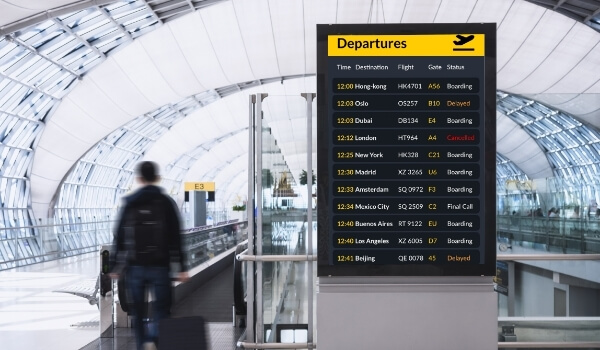
Digital signage solutions at airports have largely simplified showing real-time information about flights, reducing the burden on the ground and backend staff.
Flight Information Display Systems are computer programs that aid in collecting, processing, and displaying real-time flight-related information on digital screens.
Well-defined FIDS information must include the following –
Airline name and logo
Origin location, destination, and midway points
Time of arrival/departure
Expected or scheduled delays
Gate number for arrival/departure
Check-in counter number
Flight status as in arrived, boarding, or delayed
Multilingual presentation of all this information
Some flight information displays are so large that they can simultaneously accommodate other content like advertisements, digital notice boards, or live infotainment.
Airports are not only notoriously hectic but also way too difficult to navigate, especially if a passenger is new to flying. From terminals to baggage-collection belts to airport cafeteria and lounges, the journey of a passenger within the premise can feel like exploring a mini-city.
A smart choice for an airport here would be interactive digital screen installation. This will show passengers the floor map, guide them to their destinations. With a simple QR code feature, the area maps can also be made available on the travelers’ phones.
Touch screen interactive wayfinding solution offers personalized information to passengers. Someone is trying to locate the baggage claim, while others may be searching for the way to the terminal. Instead of finding out from one static digital sign displaying key airport landmarks highlighted on the map, it’s easier to click, zoom in, follow animated graphics pointing out the route, and understand how to reach point B from point A.
Also Read: A simple guide to digital wayfinding
Many passengers, mainly first-time flyers, find security screening checkpoints intimidating. The main reason behind this is that they are not quite aware of why screening is necessary and how it is conducted.
With airport digital signage solutions, travelers can be informed about the screening process, why it’s necessary, how the x-ray machines are no threat to their health and why they need to take off belts or ornaments.
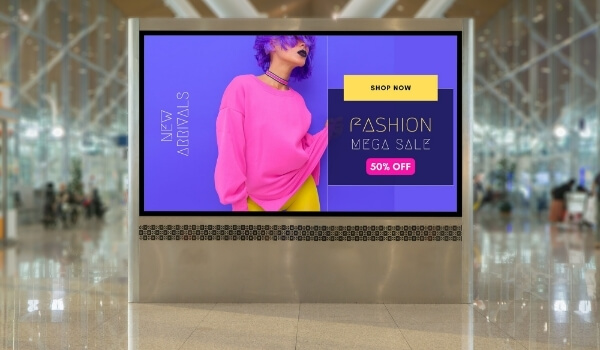
Retail shops, billboard advertisements, and digital walls or video walls can be a great source of revenue for airports.
Even outdoor billboards are great spaces for advertising, and popular brands know that very well. They crave airport advertisement spaces.
The same goes for retail shops inside airports. They help passengers satisfy their munch cravings during long wait hours. Therefore they love those little shops. Many retailers are constantly on the lookout for this opportunity. If airports have available ad space, they can rent it and earn a lump sum.
Another great way of deploying digital signage at airports is to use it for video or graphic walls. Big brands are ready to collaborate with airports and run creative video campaigns to appeal to a more extensive customer base.
Thus, digital signage solutions can bring parallel business to airports.
Airports are all about waiting. But you can turn this wait time into fun by offering an infotainment package to the passengers.
Screens in the waiting areas can display news, weather widgets, sports updates, run live TV channels, or play music videos. Airports can also use this opportunity to promote travel and tourism in their provinces by deploying an interactive information center. These information centers can help tourists learn about the history of the place, the best tourist attractions, food cultures, festival timelines, helpline numbers, and whatnot.
Airports can also have small digital displays with headphones attached to offer a good gaming time to the awaiting passengers. Many airports are leveraging AR/VR technology to include high-end games to entertain passengers with smart digital signage solutions.
In an airport, usually, a passenger deplanes at a far-off location from where they’re supposed to collect their luggage. The number one factor that makes passengers irritable is the time to reach the exact baggage claim. The other aspect is the likelihood of misplacing or losing the baggage.
Airport digital displays can show which conveyor belt is allocated to which flight and the estimated time for the baggage to arrive at the carousel.
Digital signage at airports is also a convenient tool for easy internal communication, which is the key to successful management. Managers, supervisors, counter staff, and every other airport employee can receive and exchange meaningful information in a jiffy with the help of airport digital signage. Things they can communicate through dedicated digital screens are as follows –
Announcements and notifications regarding shifts and duties
Alert on late flights or early arrival of flights
Work policy updates and changes in the work process
Security threat or emergency alert to take precautions — silent and non-panicky distribution of messages can happen here with digital signage
Employee recognition and birthday messages
Fun facts and entertaining content to uphold a positive work culture
The list can go on.
So many benefits to gain out of airport digital displays! That’s why airports across the globe keep on embracing digital signage solutions in their own exclusive ways.
With the diverse footfall of travelers at an airport nearly every second, it is essential to have all information available in multiple languages. Here are a few examples of airport digital signage usage for language translation:
Interactive translation services at Airport Information Desks: Airport information desks are usually the first contact point for passengers seeking assistance, and a multilingual interface can significantly improve communication by providing translation services for passengers who may not be familiar with the local language.
Multilingual Digital Signage for TSA Screening at Airports: This includes information in local languages on what items are allowed or prohibited, how to prepare for screening, and what to expect during the process. By providing such info in multiple languages, airports can improve communication and understanding while ensuring that all passengers are treated fairly regardless of their background.
Strategic Advertising in multiple languages: Airports are a prime advertising location as they attract a large and diverse audience. Carefully planned placement of digital ad boards in several languages can help boost brand visibility and reach many potential customers. Different languages could be used to display advertisements, product promotions, and brand messaging dynamically and engagingly.
Airport operators must prioritize creating an inclusive and accessible environment for all passengers, including those with special needs. By implementing digital airport signage that provides clear and consistent information in multiple languages, including braille, they can enhance the customer experience for visually-impaired passengers. This could include floor maps and directions to specific facilities, accessible parking, and drop-off points.
One-tap assistance requests and wheelchair accessibility can also greatly improve the experience for those with special needs, and it’s crucial that airport operators prioritize implementing these features. Ultimately, investing in accessibility measures is not only the right thing to do but also helps to create a more positive customer experience for all passengers.
Digital signage solutions at airports help generate data that improve efficiency and help make better-informed decisions. By using signage analytics, airports can gain insights into how many people view a sign at a time, for how long, and what actions are undertaken.
With these, dashboard admins can plan the placement and timing of content alongside testing different layouts, fonts, and designs to figure out the most effective ones. Digital signage analytics thereby aids airports in making data-driven decisions about their overall infrastructure.
When it comes to airport display screens and their use, the sky is the limit.
However, the greater majority of airports across the world are yet to explore digital signage technology to its full merit. We have listed a few less-explored use cases and benefits of airport displays to inspire innovation.
A quick touch on the digital screens and the passengers complete their check-in process! Voilà.
Yes, self-check-in kiosks can improve operational efficiency and reduce perceived wait times in the queues. This can be upgraded further with automated bag-drop technology allowing passengers to print their luggage tags and boarding passes on their own.
Travelers can even place the luggage into the baggage system themselves using an easy-to-use interface on digital signage screens.
Watch this Thai Airways video to see how self check-in kiosks work in real life:
All the industries have been putting a strong emphasis on biometrics as an essential technology to have on-premise. Airports have not yet marked it as a top priority, but soon they will.
Face detection, as an emerging trend in biometrics technology, will help airports ensure safety and security to a great extent. While tapping into the immense scope of this technology created by data & analytics gathered, airports will surely focus on protecting passengers’ privacy. But with digital screens executing face detection, terror threats can be avoided too.
Plus, checking-in and flight boarding gets twice as faster.
In 2021, Delta Airlines rolled out a facial biometric-based check-in solution at the Hartsfield–Jackson International Airport, Atlanta. This video shows how the technology works:

Being such overly crowded places, airports must have foolproof plans to handle and mitigate panic and anxiety if something goes wrong. An emergency messaging system powered by digital signage software can become a part of a rapid response strategy.
A network of connected airport screens can synchronously broadcast emergency messages in just a few seconds. The digital screen management software can also send different messages to different airport screens or screen groups. These messages can include alert notifications, exit directions to visitors, protocol reminders to airport staff, demonstration of safety equipment handling, helpline numbers, and so on.
Airports can collaborate with food delivery partners and have digital monitors located at different points to pre-order food and beverages for long flights.
They can also allow passengers to order food and drinks from the airport F&B counters, maybe until one hour before the flight. Passengers can buy their favorite food items and secure a sumptuous meal for their journey.
Notable brands can reach their global base of consumers by arranging virtual business events or expos on large displays and video walls. It’s a win-win for all three parties: passengers can enjoy virtual exhibitions or live interactions, brands get their desired exposure, and airports can monetize their existing screens.
Airport authorities can also run their own virtual expo showcasing their latest upgrades, advanced solutions, improved passenger experience, and inspirational stories.
Digital signage can serve various purposes across the vast airport landscape, from basic passenger information to entertainment to disaster management and whatnot.
The possibilities with airport digital signage solutions mentioned in this blog are just a drop in the bucket. Looking at the sky-rocketing speed at which the industry is embracing digital signage, the experience of flying gets better and more secure.
Take complete control of what you show on your digital signage & how you show it.
Start Free Trial Schedule My Demo
Oct 12 2022
10 min read

Jul 15 2022
8 min read
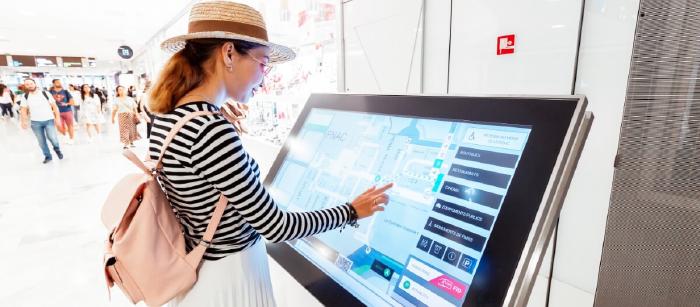
Jul 15 2022
9 min read
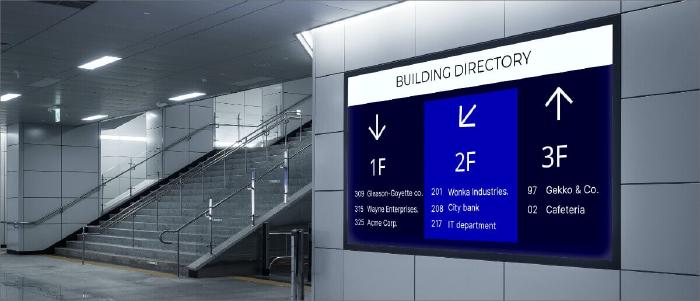
Mar 11 2022
6 min read